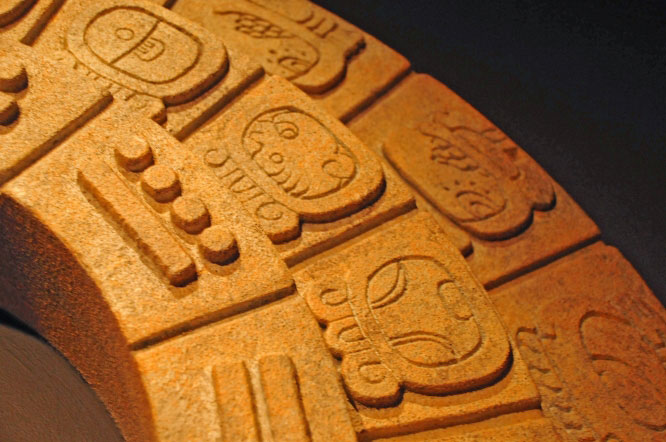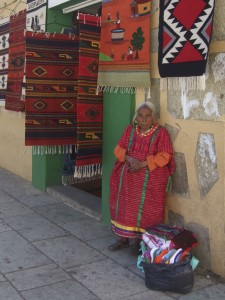Living Maya Time
This replica of a Mayan Calendar Round represents September 21, 2004, the opening of the Smithsonian’s National Museum of the American Indian on the National Mall. The calendar round is actually two separate calendars, or cycles, one cycle governs religious practices (260 days) and the other governs agricultural work (365 days). (Photo by Mollie Stephey)
Today is not only the first day of Native American Heritage month but also marks the launch of Living Maya Time – Viviendo el tiempo maya—a bilingual website dedicated to highlighting Maya culture and dispelling doomsday myths about the end of the Maya calendar in 2012. The website, created by the National Museum of the American Indian, goes live Nov. 1, 50 days before the completion of the Maya Long Count Calendar Dec. 21.
The ancient Maya, an advanced civilization who thrived in Mesoamerica from approximately 2000 BC to 900 AD, are renowned for their knowledge of astronomy, mathematics, timekeeping and the cycles of celestial objects, as well as hieroglyphic writing, architecture and agriculture. The Maya Calendar System is a tangible expression of this scientific and cultural legacy. The Maya used their knowledge of the zenith passage of the sun to accurately calculate the length of the solar year, invented the mathematical concept of zero and developed several calendars (Tzolk’in, Haab and Long Count) that interlock in sequential cycles, with the Long Count Calendar culminating Dec. 21.
The Maya devised their ceremonial calendars and agricultural calendars through a deep understanding of the interconnection between the sun’s movements and the cycle of corn. There is a large population of Latinos now living in the U.S. who originally came from Mesoamerica and whose ancestral roots are indigenous. In California alone, there are more than 50,000 Yucatec Maya immigrants who speak their native language and identify strongly with their cultural heritage. Today, more than 7 million Maya people live in Mesoamerica and other parts of the world.
One of the key messages of the website is to share how the Maya still use a sophisticated calendar system based on astronomical observations to organize their lives in concert with the cycles of the cosmos. The Maya Calendar System was designed to unlock the mysteries of the universe, a yearning that is held in common by all humankind throughout time and across cultures.
The Living Maya Time website provides a unique opportunity to display the museum’s Maya collection in the context of science and mathematics. The multimedia website provides accessible and fundamental background on the Maya Calendar System and contemporary Maya cultural practices, while offering educational activities for middle-school classrooms focused on Maya math and astronomy. The unique learning opportunity afforded by the Living Maya Time website allows the Maya of today, and Latinos generally, to intimately know the astronomical legacy to which they belong and their place in the story. Maya perspectives are shared through a series of video interviews, along with the scholarship of leading experts who have studied the Maya Calendar System. Students and the public can engage with several interactive tools, including Maya math, a Maya calendar Converter and hieroglyph-decoding tools.
Posted: 1 November 2012










